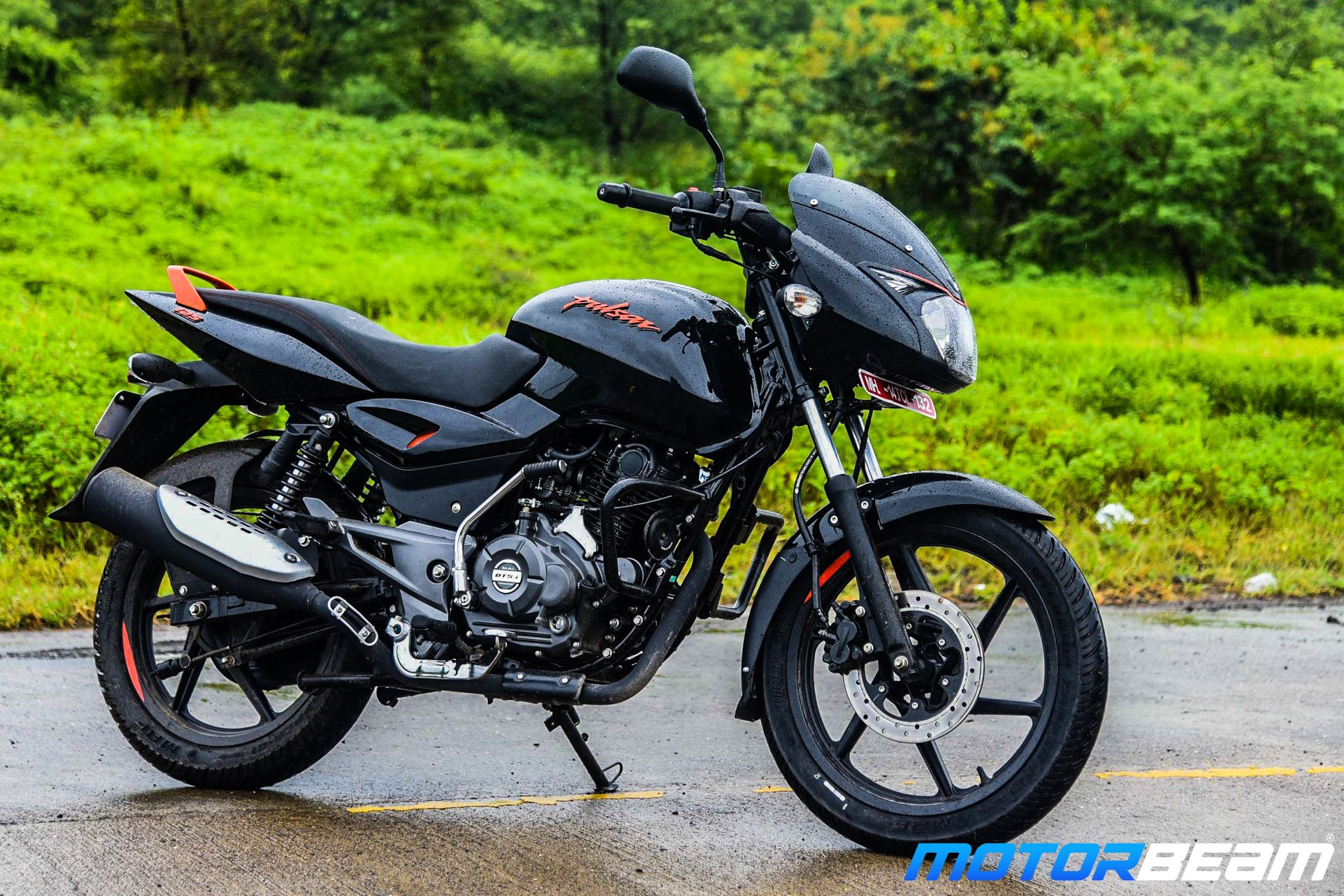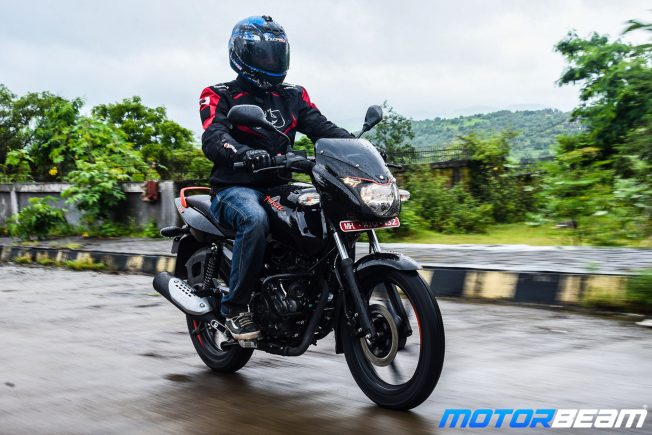
Bajaj Pulsar 125 Neon Review
Bike Tested: Bajaj Pulsar 125 Neon; Road Test No. 1130; Test Location: Pune
Price OTR Mumbai: Rs. 80,645/-
The Pulsar 125 Neon makes the ‘Definitely Male’ brand go even more affordable
Since 2001, many Pulsars have been launched in the Indian market and the Bajaj Pulsar brand has always been ruling over the entry-level sports-commuter segment. They did have the Discover 125 and the Pulsar 135 but none of them seemed to work well for the company. But just a few weeks back, a new Pulsar 125 Neon was launched and it is the new entry-level and the most affordable model of the ‘Definitely Male’ brand. The Pulsar NS 125 which is sold in the international markets was expected to join the fleet, but as the people out here prefer the old Pulsars instead, the Pulsar 125 was launched. The new Pulsar 125 Neon is based on its elder sibling, the Pulsar 150 Neon, we took the new 125 Neon out for a spin to see if it lives up to its tagline – ‘Long Live the Thrill’.
Motor Quest: The Bajaj Pulsar brand was introduced back in 2001 with the launch of twin Pulsars – the 150 and the 180. In 2012, a newer platform was introduced and based on it there are a total of six variants of the Pulsar. Launched this year, the Pulsar 125 Neon is based on the Pulsar 150 and also gets its powerplant sourced from the 150 with a shorter stroke.
The Pulsar 125 looks sleeker as the tank is now thinner
Styling – As said earlier, the Pulsar 125 Neon is based on the Pulsar 150 Neon and hence differentiating between the two is a task. One can only differentiate between them if he/she knows well about both the bikes. The Pulsar 125 Neon is offered in three colour schemes – matt grey paint with blue highlights called Neon Blue and the rest two get gloss black paint with red and silver highlights called Neon Red and Neon Silver. The highlights include a small line over the headlight, Pulsar badge, and grab-rail, streaks on its black alloys and the side panel mesh and a 3D variant logo near the grab-rail. On the front, a tinted visor sits on the wolf-eyed headlight with twin pilot lights.
Design language hasn’t changed a bit, carries the same clues from the Pulsar family
Small highlights all over is very similar to the Pulsar 150 Neon
Its tank is sculpted well and seamlessly narrows towards the long seat which is raised at the rear and the whole silhouette sums up with vertically stacked infinity twin-strip LED tail-lights. The Pulsar 125 Neon also sports first-in-class clip-on handlebars and the instrument cluster gets a faux carbon-fibre finish. The black 6-spoke alloy wheels with thin highlight and gunmetal finish on the engine casing add up to the visual appeal. The neon colour and highlights do give the bike a peppy styling but the evergreen Pulsar design now looks out-dated as it has been there in the market for many years now.
The traditional cluster which has been seen on almost all the Pulsars
Instrument Cluster and Switchgear – The Pulsar 125 Neon boasts the same old instrumentation which has been in use now for the more than 13 years! The right side houses the digital speedometer while the left houses the tachometer. The orange-backlit LCD display shows speed, the side stand indicator, fuel gauge and an odometer with twin trip meters. The addition of a clock would have proved to be a boon factor as time is important these days. The switchgear on this 125 Neon is carried over from the Pulsar 150. They are white-backlit and the right side switchgear misses out on the headlight switch as it gets the AHO functionality but there is an engine kill switch on offer which is very helpful during city commutes. Rest everything remains the same and feels good to use but does have a plastic-y feel to it.
Seating posture and the seat height is exactly similar to the Pulsar 150
Ergonomics – Pulsars have always been known for great riding comfort and the Pulsar 125 Neon is different. It gets a single-piece seat which is not very comfortable as it feels a bit hard and needs more cushioning. But the centre-set footpegs and easy-to-reach wide clip-on handlebars provide a relaxed upright seating position. This combination also offers a slightly leaned-in posture for the rider. It has a saddle height of 790 mm which is pretty friendly for both short and tall riders. The grab rail feels sturdy and the big rearview mirrors offer a good view of what’s behind. Ergonomically the Pulsar 150 and the Pulsar 125 are perfect sporty-commuters.
Reaching triple-digit speeds does require some effort
Performance – The Pulsar 125 Neon is powered by a 124.4cc BS4 compliant DTS-i engine that has been sourced from the Pulsar 150 Neon with a shorter stroke. So basically, the 125’s engine is an over-square engine where the stroke is shorter than the bore. As the stroke is shorter, the engine revs fast and also builds up power faster. The maximum power produced by the engine is of 12 PS at 8500 RPM and maximum torque of 11 Nm comes at 6500 RPM. Both the figures are 2 PS and 2.4 Nm lesser than the Pulsar 150. Even with such power figures, it is a powerful bike in its segment. The low-end and mid-range performance are strong enough, thanks to the ExhausTEC system that has improved the torque output. But the motor lacks the punch near redline and also lacks the initial pickup because of the weight of the motorcycle.
The motor feels quite refined and has enough grunt too
This Pulsar has a similar but silent exhaust note as compared to its sibling
NVH levels are kept under control and the engine feels quite smooth and refined thanks to the counter-balancer. We did not experience many vibrations unless the motorcycle crossed 80 km/hr speed, which were negligible. The outright acceleration of the motorcycle isn’t as impressive as the mileage claimed by ARAI which is of 57.5 km/l. In short, one can go cruising around over 650 kms in its small 11.5-litres fuel tank. The engine is mated to a 5-speed gearbox which is slick and crisp. Shifting of gears helps in smooth and easy cruising through the city and on highways. While the top speed is 105 km/hr, the motorcycle weighs 140 kgs and has a power to weight ratio of 85.7 PS/ton.
Stays planted but does not inspire much confidence while cornering
Riding Dynamics – The suspension, brakes, tyres are all carried over from the Pulsar 150 Neon. The motorcycle rides on a single down-tube frame. The telescopic suspension at the front and twin gas shocks at the rear offer a planted ride over bad roads and small undulations are soaked up very well. The longer wheelbase of 1320 mm helps a lot in straight-line stability. At 140 kgs, the Pulsar 150 Neon is no light-weight motorcycle and is only 4 kgs lighter than the Pulsar 150 Neon and around 15 kgs heavier than other 125cc bikes. However, the Pulsar 125 stays planted no matter what the road conditions are.
Seating comfort isn’t the best according to 125cc category, it’s rather sporty
The riding dynamics come from the elder brother while the performance feels a little bogged down
The 240 mm disc brake at the front has great feedback while the rear 130 mm drum brakes do not have enough bite to them. What’s good about the brakes though is the addition of combined braking system. This system applies the front brake automatically on the application of the rear brake. But be sure to make proper use of both brakes as under hard rear braking, the rear wheel skids at times. The Eurogrip tyres on our test bike had adequate grip but nothing to write home about, however, MRF Nylogrips are also available which should perform better. The overall riding dynamics are sufficiently good for a 125cc commuter motorcycle.
On the inside, it is still a Pulsar; sporty and ready to burn some rubber!
Verdict – The Pulsar 125 Neon, a new entry-level commuter bike, has been launched to appeal to a wider audience and also avoid the ABS rule has made this motorcycle the most affordable Pulsar ever. With all the genes of the Pulsar 150 Neon, owning this motorcycle feels like owning a Pulsar 150 Neon in a smaller package. We would have loved to welcome the NS 125 too, which is sold in international markets because of its aggressive and modern design to whose comparison this Pulsar feels out-dated. Although it costs only Rs. 6000/- less than its elder sibling, once BS6 norms kick in, the price difference between the 125cc and 150cc Pulsars will widen as the former will continue with a carb set-up while the latter will have to switch over to FI. Thus for those looking for a stylish and muscular motorcycle without worrying much about mileage and purchase price, the Pulsar 125 Neon ticks the right boxes for them.
Twin LED strips on the tail-light are a Pulsar trademark
What’s Cool
* Peppy styling with neon highlights look good
* Ergonomics are comfortable with an upright seating posture
* Combi-braking system with optional front disc has good feedback
What’s Not So Cool
* Motorcycle feels heavy for the performance
* The engine feels tuned down a bit too much against its elder sibling
Old design but it still look quite intimidating!
Bajaj Pulsar 125 Neon Specifications
* Engine: 124.4cc, Air-Cooled, 4-Stroke, Single-Cylinder
* Power: 12 PS @ 8500 RPM
* Torque: 11 Nm @ 6500 RPM
* Transmission: 5-Speed
* Fuel Type: Petrol
* Fuel Consumption: 57.5 km/l (ARAI certified)
* Frame: Single Down Tube Frame
* Tyres: 80/100/17 (Front), 100/90/17 (Rear)
* Suspension: Telescopic Forks (Front), Twin 5-Step Adjustable Nitrox Shock Absorbers (Rear)
* Brakes: 240 mm Disc (Front), 130 mm Drum (Rear)
Bajaj Pulsar 125 Neon Dimensions
* Length x Width x Height: 2055 mm x 755 mm x 1060 mm
* Wheelbase: 1320 mm
* Ground Clearance: 165 mm
* Seat Height: 790 mm
* Fuel Tank Capacity: 11.5-litres
* Kerb weight: 140 kgs
[wp-review id=”241725″]





